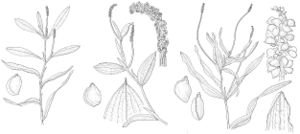Potamogeton illinoensis
Botanical Gazette 5: 50. 1880.
Rhizomes present. Cauline stems terete, without spots, 28–120 cm; nodal glands absent. Turions absent. Leaves both submersed and floating or the floating absent, ± spirally arranged. Submersed leaves sessile or petiolate, lax; stipules persistent, conspicuous, convolute, free from blade, light brown to red-brown, not ligulate, 1–8 cm, not fibrous, not shredding at tip, apex acuminate; petioles if present 0.5–4 cm; blade red-brown to light green, elliptic to lanceolate or rarely linear, often arcuate, 5–20 cm × 2–45 mm, base acute, margins entire, often crispate, apex not hoodlike, acute-mucronate, lacunae in 2–5 rows each side midrib; veins 7–19. Floating leaves: petioles continuous in color to apex, 2–9 cm; blade adaxially light green, elliptic to oblong-elliptic, 4–19 cm × 20–65 mm, base cuneate, apex round-mucronate; veins 13–29. Inflorescences emersed, unbranched; peduncles not dimorphic, terminal or axillary, erect to ascending, cylindric, 4–30 cm; spikes not dimorphic, cylindric, 25–70 mm. Fruits sessile, grayish green to olive green, obovoid to ovoid, laterally compressed, abaxially keeled, laterally ridged, 2.5–3.6 × 2.1–3 mm, abaxial keel well developed, lateral ridges without points; beak erect to slightly recurved, 0.5–0.8 mm; sides without basal tubercles; embryo with 1 full spiral. 2n = 104.
Phenology: Flowering and fruiting summer–fall.
Habitat: Alkaline waters of streams, rivers, lakes, ponds, and sloughs
Elevation: 0–2700 m
Distribution

B.C., Man., N.B., N.W.T., Ont., Que., Ala., Ark., Calif., Colo., Conn., Fla., Ga., Ill., Ind., Iowa, Kans., Ky., Md., Mass., Mich., Minn., Mo., Mont., Nebr., N.H., N.J., N.Y., N.C., Okla., Ohio, Oreg., Pa., S.C., S.Dak., Tex., Utah, Vt., Va., Wash., W.Va., Wis., Wyo., Mexico, West Indies, Central America, South America.
Discussion
Potamogeton illinoensis and P. gramineus are often difficult to separate. Certainly, in the extreme of each they are easily separated, but they continually grade into each other. Features to look for are the acute-mucronate apex of the submersed leaves of P. illinoensis and the acuminate apex for P. gramineus. Also, the number of veins seems to work as well.
Three hybrids, Potamogeton illinoensis × P. nodosus (= P. × faxonii Morong), P. amplifolius × P. illinoensis (= P. × scoliophyllus Hagström), and P. gramineus × P. illinoensis [= P. × spathuliformis (J. W. Robbins) Morong], have been described.
Selected References
None.
